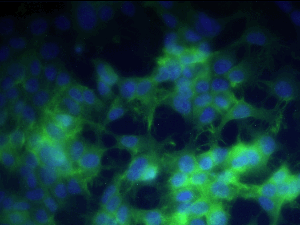Top Five Targeted Toxins
#1. 192-IgG-SAP (192-Saporin) (Cat. #IT-01) targets cells expressing rat p75NTR
#2. Anti-DBH-SAP (Cat. #IT-03) targets cells expressing rat dopamine beta-hydroxylase (DBH)
#3. mu p75-SAP (Cat. #IT-16) targets cells expressing mouse p75NTR
#4. IB4-SAP (Cat. #IT-10) targets cells expressing α-D-galactopyranoside residues
#5. Mac-1-SAP mouse/human (Cat. #IT-06) targets cells expressing mouse / human mac-1 (CD11b) receptor
TOP TARGETED TOXIN OF 2013
192-IgG-SAP (192-Saporin) (Cat. #IT-01) targets cells expressing rat p75NTR

Top Five Secondary Conjugates
#1. Mab-ZAP (Cat. #IT-04) Uses your primary mouse monoclonal antibody
#2. Streptavidin-ZAP (Cat. #IT-27) Uses your biotinylated material in order to evaluate the ability of the reagent to internalize upon binding to its receptor
#3. Anti-6 His-SAP (Cat. #IT-52) Uses your 6-His-tagged proteins over-expressed in cells
#4. Rab-ZAP (Cat. #IT-05) Uses your primary rabbit affinity-purified polyclonal IgG antibody to target and eliminate cells
#5. Fab-ZAP rat (Cat. #IT-55) Uses your primary rat monoclonal IgG antibody
TOP SECONDARY CONJUGATE OF 2013
Fab-ZAP human (Cat. #IT-51) Uses your primary human monoclonal IgG antibody to target
Top Five Antibodies
1. NGFr (mu p75) Rabbit Polyclonal (Cat. #AB-N01)
2. NGFr (ME20.4, p75) Mouse Monoclonal (Cat. #AB-N07)
3. trkA Rabbit Polyclonal (Cat. #AB-N03)
4. NGFr (mu p75) Rabbit Polyclonal, affinity-purified (Cat. #AB-N01AP)
5. Angiotensin II receptor (AT-2r) Rabbit Polyclonal, affinity-purified (Cat. #AB-N28AP)
TOP ANTIBODY OF 2013
NGFr (ME20.4, p75) Mouse Monoclonal (Cat. #AB-N07)

Top Five in Publications
#1. 192-IgG-SAP (192-Saporin) (Cat. #IT-01) targets cells expressing rat p75NTR
#2. Anti-DBH-SAP (Cat. #IT-03) targets cells expressing rat dopamine beta-hydroxylase (DBH)
#3. SSP-SAP (Cat. #IT-11) targets cells expressing substance P (NK-1) receptor
#4. mu p75-SAP (Cat. #IT-16) targets cells expressing mouse p75NTR
#5. Streptavidin-ZAP (Cat. #IT-27) Uses your biotinylated material in order to evaluate the ability of the reagent to internalize upon binding to its receptor
